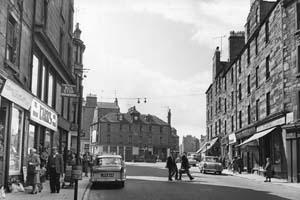
The West Port is the name given to the thoroughfare which extends as a continuation of the Overgait from South Tay Street to Hawkhill. There is not, nor ever was, a West Port exactly here, but the name survives to show that in the vicinity the western gateway to the burgh once stood when Dundee was walled for defensive purposes. The veritable West Port stood in the Overgait, a little to the west of Seres Wynd, now called Long Wynd. The Seres family came from Fife to Dundee previous to 1400, and Robert Seres and his son of the same name were Town Clerks of Dundee for over half-a-century. In 1492, Robert and his brother Thomas founded an Altar of St. Magnus Martyr in the Church of St. Mary. Their house stood in the Wynd, hence its original name.
The old West Port was one of the chief Gates of the burgh, as it controlled all traffic going westward or coming from that direction. It is probable that Sir William Wallace made his escape through it to the Carse of Gowrie after he had slain the son of Governor Selbie.
Its antiquity is shown from the fact that towards the close of the sixteenth century it had fallen into disrepair, and as it was still regarded as an important part of the fortifications in the burgh, its decay was brought to the notice of the Town Council. On the 12th October, 1591, the Provost, Bailies, and Council ordained “that the West Port of Ergyilis Gait be anew repairit in maist honest manner, and that ane Master of Wark be appointit thairto.” It was still valued as a defence in 1644 when Alexander Wedderburne was entrusted with the guarding of the “Overgait Barras” during Montrose’s Rebellion.
At the time of the Siege of Dundee in 1651 an order was given by the Town Council to repair the fortifications which “are waik in sundrie pairtes;” and it appears that the West Port suffered severely at the hands of General Monck. In February, 1668 , the ruined structure was ordered to be taken down and “ane broad and even Port to be set up agayne.” This structure was demolished in 1757 because of its being “a great inconvenience or nuisance to all entering at this quarter of the town”.
In Crawford’s map of Dundee, published in 1777, the gate is not shown, but the passage west of its original site is named “West Port”. The Building with clock at the west end of this passage stands on the site where the first Hunter of Blackness erected the Barns of Blackness about 1750, for agricultural purposes. His descendant, David Hunter of Blackness (born 1802, died 1882) feued the sites in South Tay Street, and before 1821 he had replaced the old Barns with existing buildings as far west as Hunter Street in the Hawkhill. The ancient name is still preserved in “Barns Court” on the ground where the Barns once stood.
Source: ‘Glimpses of Old and New Dundee’ – A.H. Millar, January 1925
